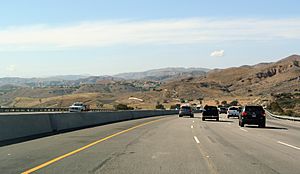Simi Valley (valley) facts for kids

Simi Valley is a special kind of valley in Southern California, USA. It's like a hidden valley because mountains and hills surround it. To the east, the Santa Susana Pass and the 118 (Ronald Reagan) freeway connect it to the San Fernando Valley. To the west, the Arroyo Simi and the Reagan Freeway link it to Moorpark and Ventura, California. The flat part of the valley has soil made from rocks like shales and sandstones. These rocks came from the nearby Santa Susana Mountains to the north and the Simi Hills.
Contents
What is Simi Valley Like?

Simi Valley is next to the Santa Susana Mountains in the north and the Simi Hills in the east and south. This valley covers about 62 square miles in southern Ventura County. It also borders the San Fernando Valley in Los Angeles County. The Santa Clara River Valley is in the northwest part of the area.
The land here ranges from about 250 feet high in the low riverbeds to over 2200 feet high in the mountains. Many steep slopes form the edges of the valley. In the southeast, a smaller area called Little Simi Valley is separated by hills. This area is drained by the Arroyo Simi and Arroyo Las Posas.
How the Valley Was Formed
The rocks and land in Simi Valley tell a long story about how it was made. The oldest rocks found here are from a time called the Cretaceous Period. This was a very long time ago, even before the dinosaurs disappeared!
Later, during the Oligocene Epoch and Miocene Epoch (still millions of years ago), layers of sand, silt, and clay were laid down. These layers formed different rock types. Some areas even have old lava flows and volcanic rocks from ancient volcanoes.
Over time, more layers of rock formed, including deep-sea mud and clay. The most common rocks you see today are from the Pliocene Epoch and Pleistocene Epoch. These include sandstones and conglomerates, which are rocks made of pebbles and sand stuck together.
How Earthquakes Shaped the Valley
The Earth's crust is always moving, and this movement has shaped Simi Valley. Scientists study faults, which are cracks in the Earth's crust, to understand these movements. The Simi Valley area has several important faults.
One important fault is the Simi fault. It runs along the northern edge of Simi Valley. This fault has caused some parts of the land to move up and other parts to move down. This movement has created the valley's shape over millions of years. Even today, the land continues to change slowly.
Scientists use special tools to study how the ground moves. They look at old rock layers and even dig trenches to see how faults have moved in the past. This helps them understand the history of earthquakes in the area.
Images for kids


